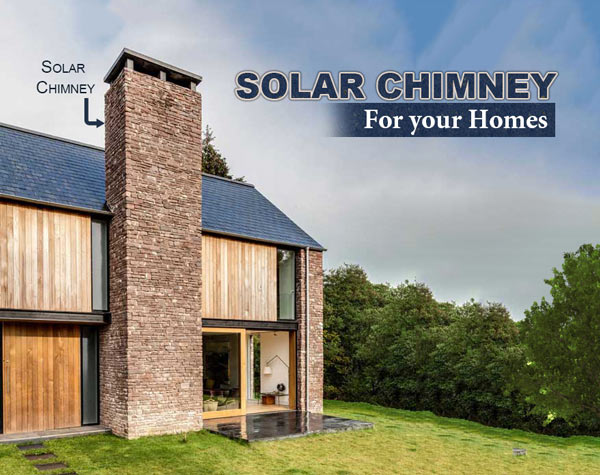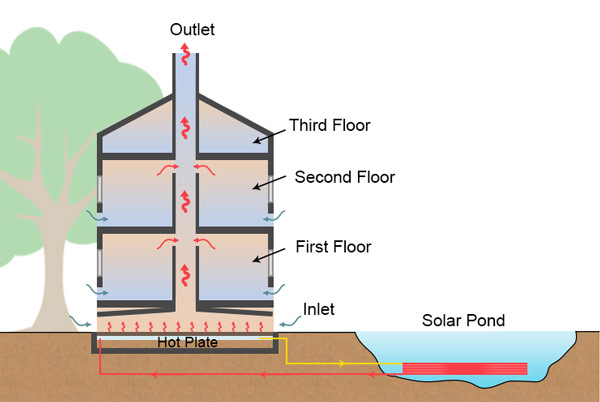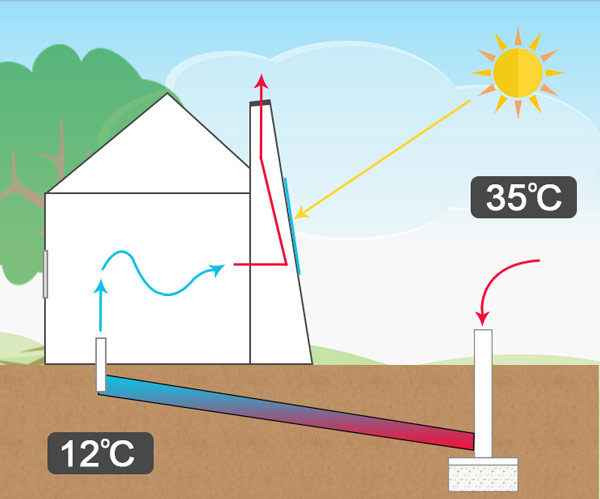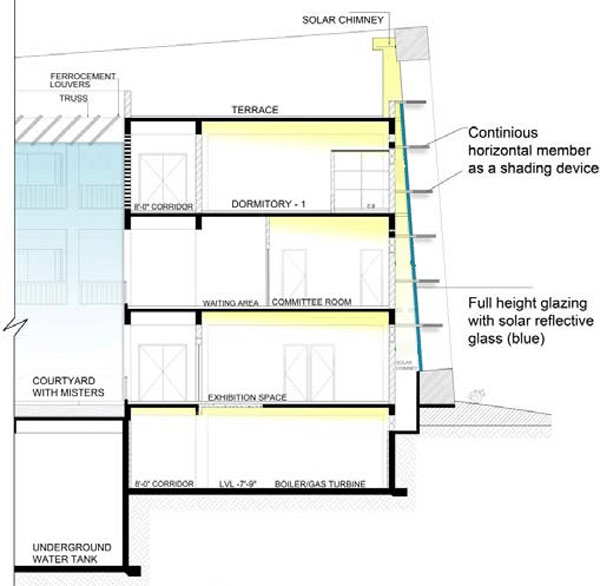Use of the solar chimney and the concept of a sustainable home are like the two sides of a coin called green living. Green lifestyle has become a global desire and in order to live green, energy efficient green buildings are enjoying priority in real estate market. For obvious reason, to pull traffic for earning better revenue in many cases. But reality is slightly different.
As said by “Arvind Krishan”, the professor of School of Planning and Architecture, New Delhi, labeling building as green building is getting a bit too commercialized and everyone seems to be jumping onto the bandwagon. We need to realize that a building is not a piece of equipment to be rated, it is architecture – a living entity for people to live and work in. Architecture is the symbiosis of tangible and intangible. The intangible refuses to be quantified but it is this component that truly makes an architecture… Solar chimney makes sustainable green homes a reality.

In order to live green, you need to implement a clean and energy efficient lifestyle. Efficient use of clean and green energy is one of the prerequisites of clean living. If we want to introduce the use of clean green energy in our daily life at reasonable cost, building a solar chimney is one of the amicable and wise solutions to get that mission accomplished.

According to Jorg Schlaich et.al. (2005) (published in Design of Commercial Solar Updraft Tower Systems— Utilization of Solar Induced Convective Flows for Power Generation), ‘a solar chimney is a solar thermal power plant, which utilizes a combination of solar air collector and central updraft tube to generate a solar induced convective flow, which drives pressure staged turbines to generate electricity.’
A solar chimney is a type of passive solar heating and cooling system that is mostly used to regulate the temperature of a building and for providing adequate ventilation. A passive solar heating and cooling system is the process of using existing building systems to regulate the internal temperature by using solar energy without using air conditioner.A solar system helps in improvement of the energy efficiency of a premise. Like a Trombe wall (a wall in a building or home that is built on the winter side having a glass layer and high heat capacity. Its internal layer is separated by a layer of glass) or solar wall. Solar chimneys are the green ways to implement energy efficient building design for promoting green lifestyle.
Basically, solar chimneys are the hollow containers connecting the inside part of the building to its outside counterpart. It is an easy and inexpensive means to heat and ventilate a building. Solar chimney works as a sustainable factor, which enhances the green value of the said building.
Sustainable design architects throughout the world are experimenting hard to boost the energy efficiency of each building-structure in urban setting on a regular basis. The solar chimney is their brain child. A solar chimney helps in cooling a house by its passive effect. Its unique, money-saving design feature attracts both the users as well as the architects and house designers.
The sustainable design features of a solar chimney may help people to reduce their energy bills up to 65%. This design of a solar chimney also has won the Presidential Citation for Sustainable Design from the “American Institute of Architects”.
How Does it Work?
A solar chimney is an example of a passive cooling and heating system powered by solar energy application. First of all, a chimney is built and coated with black or any dark material. It is made of dark color so that it can minimize the amount of sunlight reflected off the chimney, absorbing more heat thus ensuring maximum quantity of heat to be transferred inside the building in the form of air. Additionally, these chimneys are usually placed in the south direction if the house is in the North.
A solar chimney can provide both heating as well as cooling effect. But the processes are slightly different. The process of heating is quite simple. It works similar to the functionality of a Trombe wall.
Elements of Solar Energy

When the solar radiation hits the side of the chimney, the air inside the chimney gets heated. If the top exterior vents of the chimney remain closed, the heated air moves back in the living space. This provides a type of convective air heating. As the air gets cooled in the room, the lighter air tends to move up towards the solar chimney, heating it again. This cycle is repeated and the process of heating continues.
The process of cooling by solar chimney is slightly different from the process used by a Trombe wall. Two vents are built in this case. The first vent is placed at the top of the chimney. The second one is positioned at the opposite direction of the building, creating an opening between the building and the outside air to allow it inside via an easy air inlet for facilitating ventilation.

When the sunlight hits the chimney, the air inside the chimney again gets heated, but this time the vent is kept open so that the heated air escapes out. When the new air flow from outside reaches inside to fill the gap, it tends to create a “draft” providing a constant flow of cool and fresh air into the building.
A solar chimney is also known as a thermal chimney. It is a scientific way of improving the natural ventilation in a building. The ventilation gets influenced by air convection heated by passive solar energy. A simple description of solar energy is that of a vertical shaft, which utilizes solar energy to enhance stack ventilation through a building. The solar chimney along with the other green features has become a sustainable design principle for modern green homes.Architect “Rick Harlan Schneider” of iStudio Architecture says that the solar chimney and other green upgrades have yielded energy savings as high as 60%, even with an addition in some cases. The solar power has been used for centuries, especially in the Middle East, by Persians and in Europe by the Romans in ancient era.
The solar chimney includes the following basic elements:

01. The Solar Collector Area
According to Jorg Schlaich et.al. (2005) (published in Design of Commercial Solar Updraft Tower Systems – Utilization of Solar Induced Convective Flows for Power Generation), “Hot air from the solar tower is produced by the greenhouse effect in the air collector. It consists of a glass or a plastic stretched horizontally several meters above the ground”. Accordingly, this height of the glazing increases adjacent to the base of the tower. This leads to air diversion towards vertical movement. Thus, the ground under this roof heats up and air starts flowing the outside direction of the tower.
02. The Main Ventilation Shaft
Physical features like the location, height, cross-section and the thermal properties of the structure are also very crucial.
03. The Inlet and the Outlet Air Apertures
The location, sizes and the aerodynamic aspects of these elements are also equally important.
Solar Chimney and Sustainable Architecture
The solar chimney is also called heat chimneys or heat stacks. It is frequently used in architectural settings to decrease the energy used by the mechanical systems. Presently, new technologies along with the bioclimatic tower principles and traditional design strategies are generally merged to create a new and potentially successful design solution for boosting sustainability of an infrastructure.
A solar chimney serves manifold purposes like ventilating a home or office, to draw the air with the help of geothermal heat exchange, or to even ventilate a specific area like composting toilet.
Natural ventilation can be provided by creating the vents in the upper level of a building to allow warm air to rise by convection and escape to the outside.
At the same time, the cool air is drawn in through the lower vents. Trees are planted surrounding the periphery of the building to provide shade and fresh natural cool air.
As the rule of thumb, a solar chimney has to be of higher elevation than the roof level and must be constructed on the wall facing the direction of the sun. The absorption of heat from the sun can be increased by using a glazing surface on the side of the sun.
Heat absorbing materials are preferred to be used on the opposite side of the chimney. The size of the heat absorbing material has to be more than the diameter of the chimney. A large surface area allows more effective heat exchange with the air necessary for heating by solar radiation. Heating of the air in the chimney improves convection and also enhances the airflow through the chimney. Openings of the vents in the chimney should face away from the direction of the prevailing wind.

A Solar Updraft tower converts solar radiation into electricity in a natural energy efficient way by combining three principles that includes:
- the greenhouse effect
- the tower and
- the wind turbines
Hot air is produced by the solar radiation under a large glass roof. This flows to a tower in the middle of the roof and is drawn upward. This updraft drives the turbines, which is installed at the base of the tower and that produces electricity.
A 50k Wel prototype was built in Manzanares. It was planned to use it for a period of three years, but fortunately it produced electricity for seven years, thus, it proves the reliability of this new kind of solar power generating system.The Benefits of a solar chimney are as follows:
- The system of cooling in a solar chimney can be reversed during winters, providing solar heating.
- Improved control on air flow over a building can be well implemented.
- Improved ventilation in hot summers.
- Better choice of air intake i.e. on the leeward side of the building is available due to this chimney installation.
- Ventilation of narrow and small spaces with minimal exposure to external elements is implemented.
- Enhanced performance of thermal mass i.e. cooling and cool storage is possible.
- Improved thermal comfort i.e. improved air flow control, reduced draughts are easy to avail.

A solar chimney is useful for natural ventilation and for implementation of passive cooling strategies of the building. This not only helps in reducing energy use but also reduces harmful CO2 emissions and the pollution. Further, on a larger scale, it helps in improving environmental sustainability.
On a final note, solar chimney is a sustainable factor which turns out to be a bold solution for homes helping in enjoying energy efficient heating and ventilating within the premise. It is an age-old technology with a modern improvisation that provides the supply of cool and the fresh air without the use of an air conditioner.


